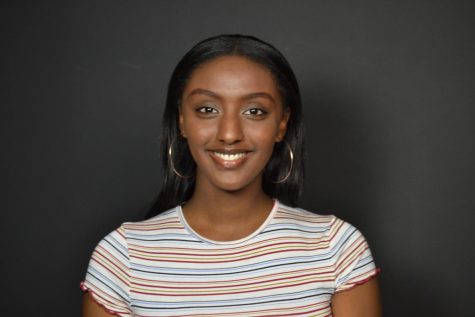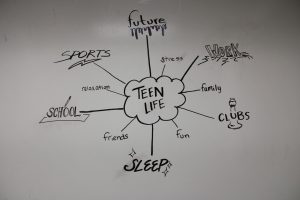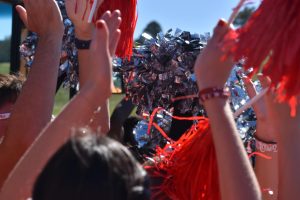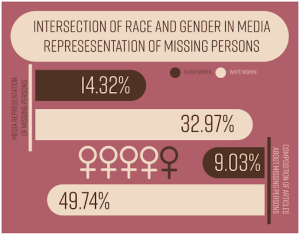Dress Code Against Durags
September 7, 2018
The dress code has often targeted women’s dress standards through its rules regarding the length and style of clothing. The rules have been adamant about making sure clothing is not a “distraction” through tedious orders. Craig Gregory a security guard at Eaglecrest stated, “When students have a dress code violation, they can be taken to the dean’s office, but they don’t get in big trouble unless it is a repeated problem.”
In the years before dress code changes were discussed it felt as though only a specific group of girls were getting picked on while others were getting away with wearing the same things. It’s all too common to notice the girls with thinner frames walking in and out of class wearing tops and bottoms that a girl with a larger frame would be dress coded for in the hall or at lunch. Now that the regulations have loosened up on tops, it feels as though any type of girl can have the freedom to choose what she wears. Suendus Qureshi stated, “ I think it’s great that they changed the dress code. There were a lot of issues with body shaming and ‘bigger’ girls getting dress coded more often while skinnier girls were let off the hook.”
Alli Avery expressed how happy she was that people could finally dress as they are, stating, “I love how students were involved in the decisions. It allows every body type to wear what they want without being picked out in the crowd and put in gym clothes. Also, it allows everyone to dress to whatever gender they identify as. It’s changing future norms for students and society in general.” The updated regulations are helping address social issues by recognition of self-identified gender.
Although the school’s new dress code done a great job of attempting to reduce body shaming, it still restricts self-expression, since it prohibits durags.
Durags are staple pieces worn mostly by African-Americans, and they provide no association with danger or interruptions. The dress code regulated for the safety and well-being of the school, and since durags disturb neither it doesn’t seem fair that they are banned. Yohannes Maneye was told to take off his durag this year and conveyed how unreasonable he thought it was. He said, “I think I should be allowed to wear a durag because it’s not hurting anybody and unlike a hoodie or a hat, you can still see my face.” The new regulation hones in on people who wear durags unreasonably since they aren’t participating in anything that puts the school at risk.
Despite the stereotypes surrounding durags and correlating them with gang violence, the durag is not a symbol of organized violence. It is simply a piece of clothing that is meant to maintain hair worn by black men and women. The dress code is creating an unnecessary ban since the durag has nothing to do with any sort of violence or distraction. It’s most notable feature would have to be its function and association with black culture. The dress code should have done more research into the function and associations of the durag instead of simply forbidding it.
The Eaglecrest dean, David DeRose, who wrote the dress code, explained how durags were banned because they cover the head, something that the dress code doesn’t support. He stated, “The dress code states no hats, hoods, or head coverings, so a durag would fall under a head covering.”
If headbands are allowed, what is the difference with wearing a durag to school? The dress code states, “Items that obscure the face, head, or ears (except as a religious observance and approved medical conditions upon administrative review) including, but not limited to hats, durags, hoods, and beanies.” However, durags obscure neither the face nor cover the ears, so the point of them being banned seems rather unreasonable. Durags are often associated with their significance to black culture. They won’t change the image of the school if students are allowed to wear them. In fact, durags were worn last year and no conflict ever arose.
Although the durag may seem like an accessory that anyone can wear, it is specifically associated with African-American history and therefore should be worn by African-American. If you look into the rich history of the durag, you’ll find that it is a black cultural and functional accessory that dates back to slavery. They were worn as headgear by poor slaves in the 19th century, but evolved as hairstyle preservers during the Harlem Renaissance and Great Depression. The Black Power Movement also inspired many to wear it as a staple of Black culture and history, so it is seen worn by black rappers, athletes, and young men. Aside from its function preserving hair, it is a piece of clothing that defines black pride, fashion, and culture.
Although the durag is worn by black men and women, durags are most popular among men. Something similar that black women wear are bonnets and satin scarves. If durags are banned, what about bonnets and satin scarves. Since they are similar in function, will they also be banned? According to Mr. Derose, “Durags and bandanas are banned, but if you are wearing a scarf or headband that is holding your hair up thats a function of your outfit so it’s fine.
Even though it seems as though the dress code didn’t look into the function of the durag there seems to be hope that there may be a day when durags can be worn. If other students also have an issue with the ban on durags they can talk to Mr. Derose. When asked if the durag was ever to be unbanned he stated, “That’s a really good question. If there are students who feel this way, they should bring it to administration and look into it.”
Although our school does a reasonably good job avoiding discriminating hairstyles, unlike other schools who are on the news for kicking kids out for wearing their natural hair or dreads, Eaglecrest should have considered how durags may be a part of a culture. Neither gang affiliated, threatening, or obscuring durags, durags are simply a piece of cloth that holds back the hair without covering the face or covering the ears.








kvion • Jan 19, 2022 at 11:34 AM
i dont like that because i think we should be alowed to wear it as part of our coulture
Heaven Coney • Apr 10, 2019 at 11:00 AM
Hi Ms.Bitew
I am writing this because I understand where you’re coming from, at my school, I am in a diversity club and we are trying to take durags and scarfs off of the dress code as it is not covering ur ears, full head, and etc. I have a group of girls who are standing with me trying to get them to take it off the dress code. They allow us to wear head scarfs but no durags which isn’t helping because durags and head scarf are almost the same. At my school girls and boys aren’t allowed to wear things that cover their head completely and, now the girls, boys and I are going to the school board to have a talk about the DCV. We are getting sent to the office for our durags and all. Schools think that durags and scarfs are gang/ violent related and when we try to have a word they shut us down, its time for a change when the teachers and stuff here were we are coming from because we are no longer hiding away being afraid of them. It had affected us to the point where we have to take it above. Its time they hear where we come from and how we truly feel. My self and others were wondering if u could do a skype call or come and visit talk to our diversity club and here a story from u. If u have time could u please write me back and let me know what u could possibly do. I hope u have a good day.
From: Heaven Coney